These archive pages are provided in order to make it easier for you to find items
that you remember seeing on the Airplanes and Rockets homepage. Of course probably
the easiest way to find anything on the website is to use the "Search AAR" box at
the top of every page.
1 |
2 |
3 |
4 |
5 |
6 |
7 |
8 |
9 |
10 |
11 |
12 |
13 |
14 |
15 |
16 |
17 |
18 |
19 |
20
21 |
22 |
23 |
24 |
25 |
26 |
27 |
28 |
29 |
30 |
31 |
32 |
33 |
34 |
35 |
36 | 37
| 38 | 39
 The AirplanesAndRockets.com website
exists entirely on the support of its visitors by way of a small percentage earned
with your
Amazon.com purchases, which typically works out
to less than $10 per month. That barley covers the domain registration and secure
server fees for AirplanesAndRockets.com. If you plan to buy items via
Amazon.com, please click on this link to begin
your shopping session from here so that I get credit for it. Doing so does not cost
you anything extra. Thank you for your support. The AirplanesAndRockets.com website
exists entirely on the support of its visitors by way of a small percentage earned
with your
Amazon.com purchases, which typically works out
to less than $10 per month. That barley covers the domain registration and secure
server fees for AirplanesAndRockets.com. If you plan to buy items via
Amazon.com, please click on this link to begin
your shopping session from here so that I get credit for it. Doing so does not cost
you anything extra. Thank you for your support.
 This looks like
something from a 1970s issue of Popular Science magazine. "Imagine
it's 2050 and you're on a cross-country flight on a new type of airliner, one with
no fuel on board. The plane takes off, and you rise above the airport. Instead of
climbing to cruising altitude, though, your plane levels out and the engines quiet
to a low hum. Is this normal? No one seems to know. Anxious passengers crane their
necks to get a better view out their windows. They're all looking for one thing.
Then it appears: a massive
antenna array on the horizon. It's sending out a powerful beam of electromagnetic
radiation pointed at the underside of the plane..." This looks like
something from a 1970s issue of Popular Science magazine. "Imagine
it's 2050 and you're on a cross-country flight on a new type of airliner, one with
no fuel on board. The plane takes off, and you rise above the airport. Instead of
climbing to cruising altitude, though, your plane levels out and the engines quiet
to a low hum. Is this normal? No one seems to know. Anxious passengers crane their
necks to get a better view out their windows. They're all looking for one thing.
Then it appears: a massive
antenna array on the horizon. It's sending out a powerful beam of electromagnetic
radiation pointed at the underside of the plane..."
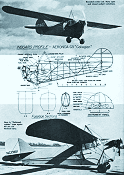 This short article and 3-view drawing by
James Trigg appeared in the February 1962 edition of American Modeler magazine.
With a 36-foot wingspan and a mere 40 horsepower for an engine, the
Aeronca C-3
performed more like a powered glider than a typical power plane. Its wing loading
of 6.15 lb/sq.ft. yielded it a climb rate of 450 ft/min and a glide ratio
of 10:1. Only 400 were built before new FAA airworthiness standards caused production
to halt. One of the first built-up glow engine models I built as a kid back in Mayo,
Maryland, was a Sterling Aeronca C-3. It was powered by a Cox Pee Wee .020 engine.
I do not remember whether it ever actually flew under power or not... This short article and 3-view drawing by
James Trigg appeared in the February 1962 edition of American Modeler magazine.
With a 36-foot wingspan and a mere 40 horsepower for an engine, the
Aeronca C-3
performed more like a powered glider than a typical power plane. Its wing loading
of 6.15 lb/sq.ft. yielded it a climb rate of 450 ft/min and a glide ratio
of 10:1. Only 400 were built before new FAA airworthiness standards caused production
to halt. One of the first built-up glow engine models I built as a kid back in Mayo,
Maryland, was a Sterling Aeronca C-3. It was powered by a Cox Pee Wee .020 engine.
I do not remember whether it ever actually flew under power or not...
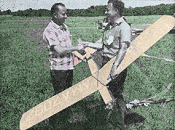 Maynard Hill is a name familiar to just
about anyone involved in building and flying model airplanes from the 1950s through
the 1980s. He set many world records, one being flying a radio controlled model
- the Skyrocket - to an altitude of 13,320 feet during a 37-minute flight on July
5, 1963 (extended to 26,990 feet in 1970). He also set speed, distance, and endurance
records. Mr. Hill, a metallurgist by profession, served as president of the
Academy of Model Aeronautics (1964) during the era this article appeared in a 1965
issue of Science and Mechanics magazine. As seen in the Model Airplane
News magazine article to the left, he used a powerful set of military binoculars
to watch the airplane during its flight. In 2003, Maynard Hill became the first
to fly a model airplane, "The Spirit of Butt's Farm," across the Atlantic Ocean... Maynard Hill is a name familiar to just
about anyone involved in building and flying model airplanes from the 1950s through
the 1980s. He set many world records, one being flying a radio controlled model
- the Skyrocket - to an altitude of 13,320 feet during a 37-minute flight on July
5, 1963 (extended to 26,990 feet in 1970). He also set speed, distance, and endurance
records. Mr. Hill, a metallurgist by profession, served as president of the
Academy of Model Aeronautics (1964) during the era this article appeared in a 1965
issue of Science and Mechanics magazine. As seen in the Model Airplane
News magazine article to the left, he used a powerful set of military binoculars
to watch the airplane during its flight. In 2003, Maynard Hill became the first
to fly a model airplane, "The Spirit of Butt's Farm," across the Atlantic Ocean...
 Specially crafted rockets soared high into
the skies April 22 at the 2011-2012
NASA Student
Launch Projects challenge. More than 500 students, representing 53 middle schools,
high schools, colleges and universities in 28 states, launched rockets of their
own design -- complete with working science payloads or engineering payloads --
at Bragg Farms in Toney, Ala. Students watch a rocket launch during the 2012 Student
Launch Projects challenge. Meet the Teams The students vied to see whose rocket
could come closest to the 1-mile altitude goal and safely return its onboard science
payload to Earth. Fifty-one teams took part, though two faced mechanical or technical
issues and did not launch... Specially crafted rockets soared high into
the skies April 22 at the 2011-2012
NASA Student
Launch Projects challenge. More than 500 students, representing 53 middle schools,
high schools, colleges and universities in 28 states, launched rockets of their
own design -- complete with working science payloads or engineering payloads --
at Bragg Farms in Toney, Ala. Students watch a rocket launch during the 2012 Student
Launch Projects challenge. Meet the Teams The students vied to see whose rocket
could come closest to the 1-mile altitude goal and safely return its onboard science
payload to Earth. Fifty-one teams took part, though two faced mechanical or technical
issues and did not launch...
 As published in the July/August 1963 issue
of American Modeler magazine, Carl Goldberg Models released a ½A-powered version
of their highly popular Falcon model airplane - the Junior Falcon (aka Jr. Falcon).
Having always been a fan of Goldberg models, I decided to build a Jr. Falcon
from plans. I was originally going to use a Cox .049 engine for power, but ultimately
decided to go with electric power since glow fuel has gotten very expensive. The
resultant 4-channel Jr. Falcon has a 480 brushless motor, ESC, and a 3-cell, 380 mAh
Li-Po battery pack. The photo to the left shows the Jr. Falcon at the end of
is maiden flight. I flew very well, but was also very fast due to the relatively
high wing loading. Its 37" wingspan and 6-3/4" chord for a 250 in2 wing area.
The specified flying weight with a single-channel escapement R/C system is 16 oz.,
which resulting in a wing loading of 9.2 oz./ft2, which is quite reasonable. As published in the July/August 1963 issue
of American Modeler magazine, Carl Goldberg Models released a ½A-powered version
of their highly popular Falcon model airplane - the Junior Falcon (aka Jr. Falcon).
Having always been a fan of Goldberg models, I decided to build a Jr. Falcon
from plans. I was originally going to use a Cox .049 engine for power, but ultimately
decided to go with electric power since glow fuel has gotten very expensive. The
resultant 4-channel Jr. Falcon has a 480 brushless motor, ESC, and a 3-cell, 380 mAh
Li-Po battery pack. The photo to the left shows the Jr. Falcon at the end of
is maiden flight. I flew very well, but was also very fast due to the relatively
high wing loading. Its 37" wingspan and 6-3/4" chord for a 250 in2 wing area.
The specified flying weight with a single-channel escapement R/C system is 16 oz.,
which resulting in a wing loading of 9.2 oz./ft2, which is quite reasonable.
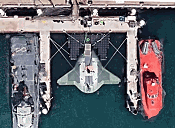 "A
top-secret US submarine prototype weapon called 'Manta
Ray' has been spotted by eagle-eyed
Google Maps users and remains plainly visible to the internet public. Satellite
photos showing the Star Wars-looking vessel docked at Port Hueneme naval base in
California went viral Sunday, its unmistakable profile standing out in stark contrast
to its dockmates. The smooth-looking autonomous vessel was named after the sea creature
for its slick design and its ability to anchor itself deep underwater while operating
in low-power mode. Produced by Northrop Grumman as part of a US Navy project to
develop long-range underwater weapons, Manta Ray is a sophisticated underwater drone
capable of hibernating on the sea floor..." "A
top-secret US submarine prototype weapon called 'Manta
Ray' has been spotted by eagle-eyed
Google Maps users and remains plainly visible to the internet public. Satellite
photos showing the Star Wars-looking vessel docked at Port Hueneme naval base in
California went viral Sunday, its unmistakable profile standing out in stark contrast
to its dockmates. The smooth-looking autonomous vessel was named after the sea creature
for its slick design and its ability to anchor itself deep underwater while operating
in low-power mode. Produced by Northrop Grumman as part of a US Navy project to
develop long-range underwater weapons, Manta Ray is a sophisticated underwater drone
capable of hibernating on the sea floor..."
 When this American Hobby Specialties ad appeared
in a 1949 issue of Air Trails magazine,
Carl Goldberg was already a well-known and respected model airplane designer
and flier. He worked for Comet and Top Flite before founding Carl Goldberg Models
in 1955. I have a particular appreciation for Carl Goldberg's accomplishments because
his 1/2A Skylane model was my very first R/C airplane kit, bought sometime around
1970. I also built a few other of his designs, the most recent of which was a Jr. Falcon,
from plans. A 1/2A Skylane was used as the basis for a tethered R/C model.
In the past half century, I have built probably five versions of the 1/2A Skylane.
One finished like the original kit, including escapement R/C equipment and an Golden
Bee .049 engine hangs on the wall as a memento to days of yore. One of my favorite
parts of perusing through my hundreds of vintage magazines... When this American Hobby Specialties ad appeared
in a 1949 issue of Air Trails magazine,
Carl Goldberg was already a well-known and respected model airplane designer
and flier. He worked for Comet and Top Flite before founding Carl Goldberg Models
in 1955. I have a particular appreciation for Carl Goldberg's accomplishments because
his 1/2A Skylane model was my very first R/C airplane kit, bought sometime around
1970. I also built a few other of his designs, the most recent of which was a Jr. Falcon,
from plans. A 1/2A Skylane was used as the basis for a tethered R/C model.
In the past half century, I have built probably five versions of the 1/2A Skylane.
One finished like the original kit, including escapement R/C equipment and an Golden
Bee .049 engine hangs on the wall as a memento to days of yore. One of my favorite
parts of perusing through my hundreds of vintage magazines...
 Klarich Custom Kits is (was) an utterly
amazing list of models available in the form of short kits. The prices were equally
amazingly reasonable, considering that most kits are made-to-order, and considering
how expensive balsa has gotten. This is a good example why I periodically review
as many website pages to make any necessary updates. This list was originally retrieved
on January 11, 2009. At the end of 2016, Klarich Custom Kits closed its doors, according
to captures by the Archive.org website. What a shame. I will leave the information
here for reference purposes... Klarich Custom Kits is (was) an utterly
amazing list of models available in the form of short kits. The prices were equally
amazingly reasonable, considering that most kits are made-to-order, and considering
how expensive balsa has gotten. This is a good example why I periodically review
as many website pages to make any necessary updates. This list was originally retrieved
on January 11, 2009. At the end of 2016, Klarich Custom Kits closed its doors, according
to captures by the Archive.org website. What a shame. I will leave the information
here for reference purposes...
 The
Carousel is
one of those C/L model airplane designs that, after reading the description, you
wonder how it was able to flown to a first place finish at the Nats. It is full
of oddball gadgetry and implementation techniques, beginning with the twin boom
configuration and a long nose moment arm. The flaps are a 3-piece deal with the
center section coupled directly to the elevator bellcrank as is normal, but the
outboard flap sections were controlled independently by a weighted pendulum arrangement
that was intended to adjust automatically based on the direction the model is pointing.
That, along with the pair of 90° bends in the elevator pushrod that was prone to
severe distortion under load, had to have made control of the Carousel very difficult.
The conclusion as to how the ship was flown to first place has to be the superior
piloting skill of Jim Vornholt. Imagine how good he must have gotten once he could
afford a better airplane. There is no doubt the Carousel looks cool, but a modern
day competitive stunt ship it is not. The
Carousel is
one of those C/L model airplane designs that, after reading the description, you
wonder how it was able to flown to a first place finish at the Nats. It is full
of oddball gadgetry and implementation techniques, beginning with the twin boom
configuration and a long nose moment arm. The flaps are a 3-piece deal with the
center section coupled directly to the elevator bellcrank as is normal, but the
outboard flap sections were controlled independently by a weighted pendulum arrangement
that was intended to adjust automatically based on the direction the model is pointing.
That, along with the pair of 90° bends in the elevator pushrod that was prone to
severe distortion under load, had to have made control of the Carousel very difficult.
The conclusion as to how the ship was flown to first place has to be the superior
piloting skill of Jim Vornholt. Imagine how good he must have gotten once he could
afford a better airplane. There is no doubt the Carousel looks cool, but a modern
day competitive stunt ship it is not.
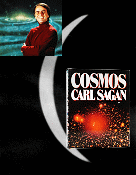 Raise your hand if you watched the original
1980 Nova "Cosmos: A Personal Journey" TV series, hosted by überastronomer Carl
Sagan. My hand is up. In fact, that might be what piqued my life-long interest in
astronomy. I was in the U.S. Air Force at the time, stationed at Robins AFB, Georgia,
as an Air Traffic Control Radar Repairman. The show motivated me to buy my first
"real" telescope, a Criterion RV-6 Dynascope, a Newtonian model on an equatorial
mount. I was surprised to run across this 1961 Popular Science magazine
article entitled, "How
to Colonize Venus." This might have been Sagan's initial foray into the public
domain. Hard as it is to believe, at the time astronomers did not know that Venus'
atmosphere, composed largely of carbon dioxide (CO2), supports clouds of sulphuric
acid (battery acid) raining down, and the planet's surface has a temperature of
more than 800° F and a pressure of more than 1300 psi. Sagan posited that
the plant's surface... Raise your hand if you watched the original
1980 Nova "Cosmos: A Personal Journey" TV series, hosted by überastronomer Carl
Sagan. My hand is up. In fact, that might be what piqued my life-long interest in
astronomy. I was in the U.S. Air Force at the time, stationed at Robins AFB, Georgia,
as an Air Traffic Control Radar Repairman. The show motivated me to buy my first
"real" telescope, a Criterion RV-6 Dynascope, a Newtonian model on an equatorial
mount. I was surprised to run across this 1961 Popular Science magazine
article entitled, "How
to Colonize Venus." This might have been Sagan's initial foray into the public
domain. Hard as it is to believe, at the time astronomers did not know that Venus'
atmosphere, composed largely of carbon dioxide (CO2), supports clouds of sulphuric
acid (battery acid) raining down, and the planet's surface has a temperature of
more than 800° F and a pressure of more than 1300 psi. Sagan posited that
the plant's surface...
 The last time I appeared in Model Aviation
magazine was around 2000 when they published a few modeling themed crossword puzzles
I constructed. Now, in the March 2016 edition, appears not just one but three honorable
mentions. Thanks to the editors. The first is in the list of donors for the AMA
Museum. Melanie paid for one of the memorial "Walk of Fame" sidewalk bricks as a
Christmas present, so my name (Kirt Blattenberger) showed up in there. The second
is in the "Focal Point" feature where models built by AMA members are posted along
with a brief description. My "Enterprise-E"
electric-powered control line model is displayed. There is a web page dedicated
to the Enterprise-E construction and first flight here on the AirplanesAndRockets.com
website. Third, but by no means least, is an account in Dave Gee's "Safety Comes
First" column that relates a scary experience I had during one flight with the Enterprise-E... The last time I appeared in Model Aviation
magazine was around 2000 when they published a few modeling themed crossword puzzles
I constructed. Now, in the March 2016 edition, appears not just one but three honorable
mentions. Thanks to the editors. The first is in the list of donors for the AMA
Museum. Melanie paid for one of the memorial "Walk of Fame" sidewalk bricks as a
Christmas present, so my name (Kirt Blattenberger) showed up in there. The second
is in the "Focal Point" feature where models built by AMA members are posted along
with a brief description. My "Enterprise-E"
electric-powered control line model is displayed. There is a web page dedicated
to the Enterprise-E construction and first flight here on the AirplanesAndRockets.com
website. Third, but by no means least, is an account in Dave Gee's "Safety Comes
First" column that relates a scary experience I had during one flight with the Enterprise-E...
 Mr.
Bill Gaylord has been gracious
enough to allow me to post photos and information about his fine Guillow's free-flight
model airplanes that he converted to electric powered R/C. The level of craftsmanship
is incredible both in the frame-up and the covering and finish. You can find lots
of photos and details of the build on the RCGroups bulletin board. I do not see
whether he has ever flown any of these models. My guess is that with the structural
beefing up required to support the motor, battery, and R/C gear results in a high
wing loading. I personally would never dare risk these models by trying to fly them!
They would all spend their days as hanger queens - display only... Mr.
Bill Gaylord has been gracious
enough to allow me to post photos and information about his fine Guillow's free-flight
model airplanes that he converted to electric powered R/C. The level of craftsmanship
is incredible both in the frame-up and the covering and finish. You can find lots
of photos and details of the build on the RCGroups bulletin board. I do not see
whether he has ever flown any of these models. My guess is that with the structural
beefing up required to support the motor, battery, and R/C gear results in a high
wing loading. I personally would never dare risk these models by trying to fly them!
They would all spend their days as hanger queens - display only...
 This is pretty cool. If I owned a good receiver,
I would definitely give it a try. In 1970 when this Popular Electronics
magazine article was written, a lot of Hams were still using
vacuum tube receivers so the recommendation to let the equipment warm up for
several hours prior to making the fine frequency adjustments was good advice. Nowadays
the warm-up time and stability of receivers should permit 30 minutes or so to suffice
(even ovenized frequency references need time to stabilize when first powered up).
Unless I missed it, the author does not explicitly state that the frequency change
measured over time is due to gravity acting on the mass of the crystal reference,
but I suspect that is his intention since part of the experiment involves disconnecting
the antenna and shielding the receiver from outside interferers. Over a lunar month
period (29.5 days) we experience... This is pretty cool. If I owned a good receiver,
I would definitely give it a try. In 1970 when this Popular Electronics
magazine article was written, a lot of Hams were still using
vacuum tube receivers so the recommendation to let the equipment warm up for
several hours prior to making the fine frequency adjustments was good advice. Nowadays
the warm-up time and stability of receivers should permit 30 minutes or so to suffice
(even ovenized frequency references need time to stabilize when first powered up).
Unless I missed it, the author does not explicitly state that the frequency change
measured over time is due to gravity acting on the mass of the crystal reference,
but I suspect that is his intention since part of the experiment involves disconnecting
the antenna and shielding the receiver from outside interferers. Over a lunar month
period (29.5 days) we experience...
 Lucky thing for budding amateur rocketeer
Allen Wechter that some of the PETA (formed in 1980) crazies were not around in
1965 when this "World's
First Astrogator" article appeared in Science and Mechanics magazine. Otherwise,
he surely would have been targeted as an animal abuser when he claimed to be the
first person to launch an alligator into [sub]space. The beast was sent to an altitude
of 8,500 feet, whereupon it floated gently down via parachute. The story mentions
that it landed two miles downwind, which in Flushing, New York, even in 1965, would
have been a mighty densely built-up region of Long Island, near New York City. He's
lucky to have retrieved it! Master Wechter claims the 'gator was "unscratched and
in excellent physical condition," but I'm guessing he was emotionally scarred for
life ;-) Lucky thing for budding amateur rocketeer
Allen Wechter that some of the PETA (formed in 1980) crazies were not around in
1965 when this "World's
First Astrogator" article appeared in Science and Mechanics magazine. Otherwise,
he surely would have been targeted as an animal abuser when he claimed to be the
first person to launch an alligator into [sub]space. The beast was sent to an altitude
of 8,500 feet, whereupon it floated gently down via parachute. The story mentions
that it landed two miles downwind, which in Flushing, New York, even in 1965, would
have been a mighty densely built-up region of Long Island, near New York City. He's
lucky to have retrieved it! Master Wechter claims the 'gator was "unscratched and
in excellent physical condition," but I'm guessing he was emotionally scarred for
life ;-)
 I remember as a kid in Mayo, Maryland, tying
a string to the nose of my
Sterling Aeronca C-3
model and towing it behind my Huffy bicycle - with a banana seat and a sissy bar
- up and down the street in front of my house. It would weave and dodge back in
forth in a sort of gyrating motion a few feet off the ground and then settle into
a fairly decent landing. Assuming the Aeronca C-3 met the same ultimate demise as
most of my models of the era, it probably succumbed to an airframe failure after
early success fed the human desire to go higher and faster than the last time. One
thing that stands out in my mind about the Aeronca was that it was one of the most
complex models I had attempted to date - especially with building the wing support
assembly on top and adding all the flying wires. The kit shown here was purchased
on eBay. It is yet another addition to my collection of model items I had as a kid.
None of my original equipment survived... I remember as a kid in Mayo, Maryland, tying
a string to the nose of my
Sterling Aeronca C-3
model and towing it behind my Huffy bicycle - with a banana seat and a sissy bar
- up and down the street in front of my house. It would weave and dodge back in
forth in a sort of gyrating motion a few feet off the ground and then settle into
a fairly decent landing. Assuming the Aeronca C-3 met the same ultimate demise as
most of my models of the era, it probably succumbed to an airframe failure after
early success fed the human desire to go higher and faster than the last time. One
thing that stands out in my mind about the Aeronca was that it was one of the most
complex models I had attempted to date - especially with building the wing support
assembly on top and adding all the flying wires. The kit shown here was purchased
on eBay. It is yet another addition to my collection of model items I had as a kid.
None of my original equipment survived...
 Back when Melanie had more time (around
1984), she made a lot of counted cross stitch pictures. This one remains her most
ambitious project ever - a large nautical map of the ancient world, fashioned after
the works of famed cartographer Gerard Mercator and titled with "Orbis Terrae
Compendiosa Descriptio," which is, loosely translated, Latin for "A Comprehensive
Description of the World." Melanie's work was done on 22-count fabric, and measures
approximately 13" by 8" (not including white border). Such a fine effort needed
a special frame, so I set about making a custom 23" by 17" frame out of teak wood
bought at World of Hardwoods in Baltimore. The fancy fluting was done on my Craftsman
radial arm saw with the molding head. Teak, as you might know, is used extensively
on boats because it weathers well. It is an oily type wood that starts out life
with a shiny golden patina... Back when Melanie had more time (around
1984), she made a lot of counted cross stitch pictures. This one remains her most
ambitious project ever - a large nautical map of the ancient world, fashioned after
the works of famed cartographer Gerard Mercator and titled with "Orbis Terrae
Compendiosa Descriptio," which is, loosely translated, Latin for "A Comprehensive
Description of the World." Melanie's work was done on 22-count fabric, and measures
approximately 13" by 8" (not including white border). Such a fine effort needed
a special frame, so I set about making a custom 23" by 17" frame out of teak wood
bought at World of Hardwoods in Baltimore. The fancy fluting was done on my Craftsman
radial arm saw with the molding head. Teak, as you might know, is used extensively
on boats because it weathers well. It is an oily type wood that starts out life
with a shiny golden patina...
 The type of glass referred to in this 1953
Science and Mechanics magazine article is not the solid sheet type made
from sand (silicon), but fiberglass. It has
strands of glass mixed into the plastic weave, hence the name. It is the glass
component that causes itching as it pricks your skin. Breathing it into your lungs
is dangerous as the minute particles of glass can lodge in the tissue. Typical of
the era, the workers shown handling the fiberglass have no protection for eyes,
nose, mouth, or skin. Fiberglass ended up not being the material hoped for because
it ultimately could not stand up to the extreme structural and thermal loads typical
of high speed aircraft. It was also not tolerant of being exposed to intense sunlight
while sitting on a tarmac. The few commercial and homebuilt fiberglass airplanes
need to be painted white to reflect as much ultraviolet light as possible to prevent
delamination and deterioration of the components... The type of glass referred to in this 1953
Science and Mechanics magazine article is not the solid sheet type made
from sand (silicon), but fiberglass. It has
strands of glass mixed into the plastic weave, hence the name. It is the glass
component that causes itching as it pricks your skin. Breathing it into your lungs
is dangerous as the minute particles of glass can lodge in the tissue. Typical of
the era, the workers shown handling the fiberglass have no protection for eyes,
nose, mouth, or skin. Fiberglass ended up not being the material hoped for because
it ultimately could not stand up to the extreme structural and thermal loads typical
of high speed aircraft. It was also not tolerant of being exposed to intense sunlight
while sitting on a tarmac. The few commercial and homebuilt fiberglass airplanes
need to be painted white to reflect as much ultraviolet light as possible to prevent
delamination and deterioration of the components...
 When deciding which type of covering material
to apply to a model airplane structure, it would be helpful to have a table of
covering density for comparison. Here
is such a table which shows, for instance, that 21st Century Fabric is the heaviest
type of covering you can use. MicroLite covering is the lightest weight. Not shown
are most doped or painted coverings because finished weights are so dependent on
substrate type (silk, Silkspan, tissue, etc.), paint or dope type, and number/thickness
of coats. To calculate the covering weight, multiply the density by the total surface
area of your model. Unfortunately, most of these coverings are no longer manufactured,
but a lot of it can still be found on eBay... When deciding which type of covering material
to apply to a model airplane structure, it would be helpful to have a table of
covering density for comparison. Here
is such a table which shows, for instance, that 21st Century Fabric is the heaviest
type of covering you can use. MicroLite covering is the lightest weight. Not shown
are most doped or painted coverings because finished weights are so dependent on
substrate type (silk, Silkspan, tissue, etc.), paint or dope type, and number/thickness
of coats. To calculate the covering weight, multiply the density by the total surface
area of your model. Unfortunately, most of these coverings are no longer manufactured,
but a lot of it can still be found on eBay...
 Peck-Polymers has been around for as long
as I can remember, which was in the late 1960s to early 1970s, when I would have
bought my first aeromodeling magazine (we relied on magazines back then for information
since Al Gore had not yet invented the Internet). In fact, Peck-Polymers was founded
in 1971 by engineer and free-flighter Bob Peck. According to the "About" page on
their website, Bob designed many of the models in the original Peck product line.
He and his wife Sandy we soon kitting designs by Bill Hannan, Bill Warner, Dick
Baxter and many others. Peck-Polymers has also long been at the forefront of design
and engineering of the many small parts that are so critical to free flight rubber
airplanes, such as the bearings and prop shafts. Bob passed away in 1991, and his
wife Sandy kept the company going until late 2007 when she sold it to Tim Goldstein
of A2Z Corp. (now defunct) Tim created the laser-cut kits. In January of 2015, Chuck
Imbergamo of Wind-It-Up Enterprises took ownership of the company and thankfully
is committed to carrying on the tradition of producing Peck-Polymer kits and accessories... Peck-Polymers has been around for as long
as I can remember, which was in the late 1960s to early 1970s, when I would have
bought my first aeromodeling magazine (we relied on magazines back then for information
since Al Gore had not yet invented the Internet). In fact, Peck-Polymers was founded
in 1971 by engineer and free-flighter Bob Peck. According to the "About" page on
their website, Bob designed many of the models in the original Peck product line.
He and his wife Sandy we soon kitting designs by Bill Hannan, Bill Warner, Dick
Baxter and many others. Peck-Polymers has also long been at the forefront of design
and engineering of the many small parts that are so critical to free flight rubber
airplanes, such as the bearings and prop shafts. Bob passed away in 1991, and his
wife Sandy kept the company going until late 2007 when she sold it to Tim Goldstein
of A2Z Corp. (now defunct) Tim created the laser-cut kits. In January of 2015, Chuck
Imbergamo of Wind-It-Up Enterprises took ownership of the company and thankfully
is committed to carrying on the tradition of producing Peck-Polymer kits and accessories...
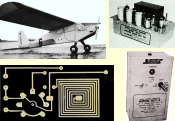 1954 was just a decade after World War II,
during which time the Army Signal Corps introduced a method of printing - or etching
- metallic circuit conductors on an insulator substrate, and thus was born the printed
circuit board (PCB). The first boards used a phenolic-paper laminate, which is the
shiny brown substrate material that is still found in some industrial applications
like motors and control panels. Ferric chloride was used to etch away the copper
foil not masked off with photoresist chemicals. I made many crude PCBs using a resist
ink pen to draw circuit traces and component mounting pads, then etched away the
exposed copper with ferric chloride
purchased at Radio Shack. This line from the article is reminiscent of people
who remarked similarly about the first televisions and computers: "One of the first
questions that arises is: 'What good is it and what do I gain by using it?'" Printed
inductors were already being used, as the photo shows... 1954 was just a decade after World War II,
during which time the Army Signal Corps introduced a method of printing - or etching
- metallic circuit conductors on an insulator substrate, and thus was born the printed
circuit board (PCB). The first boards used a phenolic-paper laminate, which is the
shiny brown substrate material that is still found in some industrial applications
like motors and control panels. Ferric chloride was used to etch away the copper
foil not masked off with photoresist chemicals. I made many crude PCBs using a resist
ink pen to draw circuit traces and component mounting pads, then etched away the
exposed copper with ferric chloride
purchased at Radio Shack. This line from the article is reminiscent of people
who remarked similarly about the first televisions and computers: "One of the first
questions that arises is: 'What good is it and what do I gain by using it?'" Printed
inductors were already being used, as the photo shows...
 As a kid living in Holly Hill Harbor, Maryland,
I managed to find many uses for those
thin plastic bags that protected garments returned from the dry cleaner. The
two most often were for parachutes and for filling with hot air to use as a balloon.
I'd tape my mother's sewing thread to a cut-out circle for a parachute, then tie
a small rock to the ends of the "shroud lines." Then, I'd fold it and wrap the lines
around it like with my Estes rockets, and chuck it as high into the air as possible.
Only when my arm got sore did the repetitions stop. The hot air balloon exercises
were not very impressive. Forming a two-dimensional piece of plastic into a three-dimensional
sphere(oid) resulted in a less than optimal enclosure, with excess material that
only added weight without adding volume for hot air. A hair dryer borrowed - usually
without permission - provided the hot (more like warm) air for buoyancy. The thin
plastic easily wrinkled if the end of the hair dyer touched it... As a kid living in Holly Hill Harbor, Maryland,
I managed to find many uses for those
thin plastic bags that protected garments returned from the dry cleaner. The
two most often were for parachutes and for filling with hot air to use as a balloon.
I'd tape my mother's sewing thread to a cut-out circle for a parachute, then tie
a small rock to the ends of the "shroud lines." Then, I'd fold it and wrap the lines
around it like with my Estes rockets, and chuck it as high into the air as possible.
Only when my arm got sore did the repetitions stop. The hot air balloon exercises
were not very impressive. Forming a two-dimensional piece of plastic into a three-dimensional
sphere(oid) resulted in a less than optimal enclosure, with excess material that
only added weight without adding volume for hot air. A hair dryer borrowed - usually
without permission - provided the hot (more like warm) air for buoyancy. The thin
plastic easily wrinkled if the end of the hair dyer touched it...
 Dave Platt - aka "Mr. Scale" - is one
of the world's most accomplished scale model airplane builders and flyers. He
somehow manages to turn out magnificently detailed scale models year after year.
If you haven't seen his "Platt's Laws of Scale Modeling," derived from his decades
of experience, you'll want to do so. He has built and flown his scale models in
the realms of free flight, control line, and radio control, using internal combustion
engines with propellers, ducted fans, and turbine jets for propulsion. There might
be someone somewhere equally qualified to comment on scale airplane modeling, but
none more qualified. When this "Find the Scale Wingspan &
Area" article appeared in a 1969 issue of American Aircraft Modeler
magazine, slide rules were the de rigueur... Dave Platt - aka "Mr. Scale" - is one
of the world's most accomplished scale model airplane builders and flyers. He
somehow manages to turn out magnificently detailed scale models year after year.
If you haven't seen his "Platt's Laws of Scale Modeling," derived from his decades
of experience, you'll want to do so. He has built and flown his scale models in
the realms of free flight, control line, and radio control, using internal combustion
engines with propellers, ducted fans, and turbine jets for propulsion. There might
be someone somewhere equally qualified to comment on scale airplane modeling, but
none more qualified. When this "Find the Scale Wingspan &
Area" article appeared in a 1969 issue of American Aircraft Modeler
magazine, slide rules were the de rigueur...
 The
Prop-Rod car
was one of the earliest models produced by L.M. Cox Manufacturing. For many years
the models went by the trade name of Thimble Drome, but later were know simply as
Cox Models. It was featured in magazine advertisements as early as 1961 when it
appeared in American Modeler. The Prop-Rod came with a Babe Bee .049 engine mounted
with its cylinder inverted, which could make starting it difficult since fuel could
pool in the glow head. As with airplanes having inverted cylinders, starting it
was often done by holding the model upside down. It was designed to run either on
a tether stretched along a sidewalk, on a tether mounted in the center of a circle... The
Prop-Rod car
was one of the earliest models produced by L.M. Cox Manufacturing. For many years
the models went by the trade name of Thimble Drome, but later were know simply as
Cox Models. It was featured in magazine advertisements as early as 1961 when it
appeared in American Modeler. The Prop-Rod came with a Babe Bee .049 engine mounted
with its cylinder inverted, which could make starting it difficult since fuel could
pool in the glow head. As with airplanes having inverted cylinders, starting it
was often done by holding the model upside down. It was designed to run either on
a tether stretched along a sidewalk, on a tether mounted in the center of a circle...
 When Air Trails magazine was running
these
airplane design contests in the 1940s and 1950s, the world was fascinated with
the concept of flight. Revolutionary airplanes like the Douglas DC−3, introduced
in the 1930s, opened up the skyways to middle class citizens, and a plethora of
surplus World War I biplanes made learning to fly affordable. Great advances
were made in aircraft design and manufacturing during World War II, and those
lessons were rapidly being applied to civilian aircraft to make flying accessible
to average people. Model aviation was also a huge interest to the young and old
alike. Static display models, simple free flight gliders and propeller driven models,
control line models with screaming internal combustion engines (ICE) were the passions
of hundreds of thousands - maybe millions. Most enthusiasts built models from kits
or plans, but others preferred to design and build their own models. They were the
visionaries... When Air Trails magazine was running
these
airplane design contests in the 1940s and 1950s, the world was fascinated with
the concept of flight. Revolutionary airplanes like the Douglas DC−3, introduced
in the 1930s, opened up the skyways to middle class citizens, and a plethora of
surplus World War I biplanes made learning to fly affordable. Great advances
were made in aircraft design and manufacturing during World War II, and those
lessons were rapidly being applied to civilian aircraft to make flying accessible
to average people. Model aviation was also a huge interest to the young and old
alike. Static display models, simple free flight gliders and propeller driven models,
control line models with screaming internal combustion engines (ICE) were the passions
of hundreds of thousands - maybe millions. Most enthusiasts built models from kits
or plans, but others preferred to design and build their own models. They were the
visionaries...
 Winged Shadow Systems has developed a solid
state electronic altimeter called
the How High™ that plugs into a spare receiver channel for power, and provides
altitude readings between 50 feet and 7,000 feet above ground level. The heart
of the system is the SM5420 pressure sensor, by Silicon Microstructures. It is a
micromachined structure molded in an 8-pin SOIC plastic package. Here is the datasheet.
Per the manufacturer, "The SM5420C is a small outline SO-8 packaged pressure sensor.
The sensor uses SMI’s SM5108C micromachined, piezoresistive pressure sensing chip
that has been optimized to provide the highest possible accuracy for a package of
this size..." News Flash:
I set a personal thermalling altitude record of 1,267 feet in my 85% Aquila glider
on May 23, 2024! Winged Shadow Systems has developed a solid
state electronic altimeter called
the How High™ that plugs into a spare receiver channel for power, and provides
altitude readings between 50 feet and 7,000 feet above ground level. The heart
of the system is the SM5420 pressure sensor, by Silicon Microstructures. It is a
micromachined structure molded in an 8-pin SOIC plastic package. Here is the datasheet.
Per the manufacturer, "The SM5420C is a small outline SO-8 packaged pressure sensor.
The sensor uses SMI’s SM5108C micromachined, piezoresistive pressure sensing chip
that has been optimized to provide the highest possible accuracy for a package of
this size..." News Flash:
I set a personal thermalling altitude record of 1,267 feet in my 85% Aquila glider
on May 23, 2024!
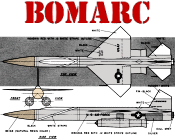 Is the
BOMARC an airplane
or a rocket? If it is an airplane, then it is the pilotless type (aka "drone").
If it is a rocket, then it is the ultimate in controlled trajectory hardware - at
least in its day. The DoD referred to it as a surface-to-air guided missile. The
name is a combination of "BOeing Airplane Company" and "Michigan
Aeronautical Research Center."
Clever, non? If memory serves me correctly (it's been 30+ years), the AN/TPX-42
IFF (Identification Friend or Foe) secondary radar system (built by Gilfillan) I
maintained as an air traffic control radar technician reserved a special "X" bit
in its data packet to designate the BOMARC - and maybe other guided missiles. That
might have been a military secret at the time, because the Air Force instructors
acted like they were divulging proprietary information when discussing why that
bit was present in an otherwise... Is the
BOMARC an airplane
or a rocket? If it is an airplane, then it is the pilotless type (aka "drone").
If it is a rocket, then it is the ultimate in controlled trajectory hardware - at
least in its day. The DoD referred to it as a surface-to-air guided missile. The
name is a combination of "BOeing Airplane Company" and "Michigan
Aeronautical Research Center."
Clever, non? If memory serves me correctly (it's been 30+ years), the AN/TPX-42
IFF (Identification Friend or Foe) secondary radar system (built by Gilfillan) I
maintained as an air traffic control radar technician reserved a special "X" bit
in its data packet to designate the BOMARC - and maybe other guided missiles. That
might have been a military secret at the time, because the Air Force instructors
acted like they were divulging proprietary information when discussing why that
bit was present in an otherwise...
 Radio control (R/C) of a model doesn't get
much simpler than the transmitter and receiver circuits shown in the schematics
of Figure 2. Of course the cleanness of the transmitted signal and the selectivity
of the receiver of that signal leaves a lot to be desired. In 1952 when this article
appeared in Radio & Television News magazine, the airwaves weren't
cluttered with wireless communications devices, but given that these radio systems
were sharing the electromagnetic spectrum with Citizens Band (CB) radio, the chances
of getting "shot down" from nearby operators was pretty high if you lived within
a few miles of where CB'ers were communicating. More sophisticated R/C equipment
was available from commercial manufacturers, but this system targeted the do-it-yourself
types and those with limited hobby budgets... Radio control (R/C) of a model doesn't get
much simpler than the transmitter and receiver circuits shown in the schematics
of Figure 2. Of course the cleanness of the transmitted signal and the selectivity
of the receiver of that signal leaves a lot to be desired. In 1952 when this article
appeared in Radio & Television News magazine, the airwaves weren't
cluttered with wireless communications devices, but given that these radio systems
were sharing the electromagnetic spectrum with Citizens Band (CB) radio, the chances
of getting "shot down" from nearby operators was pretty high if you lived within
a few miles of where CB'ers were communicating. More sophisticated R/C equipment
was available from commercial manufacturers, but this system targeted the do-it-yourself
types and those with limited hobby budgets...
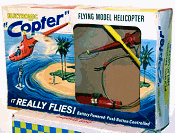 For most people my age (born in 1958), the
first experience with a "real" flying model helicopter was this
ElectroMic "Copter"
by Stanzel. I finally acquired one via eBay for a fair price. The "Copter" uses
two D-cell batteries in the plastic handle to power a motor, also in the handle,
which in turn drives the center wire of a coaxial cable that connects to the helicopter
rotor. Flying the Copter is a matter of pressing the power button and then manipulating
the handle to direct the model in flight. With fully charged batteries, the helicopter
generates a lot of lift and requires angling the control cable downward to prevent
the thing from performing the equivalent of a wingover. Forward and reverse flight
involve angling the controller left and right. After a few moments of practice,
precise control is fairly easy... For most people my age (born in 1958), the
first experience with a "real" flying model helicopter was this
ElectroMic "Copter"
by Stanzel. I finally acquired one via eBay for a fair price. The "Copter" uses
two D-cell batteries in the plastic handle to power a motor, also in the handle,
which in turn drives the center wire of a coaxial cable that connects to the helicopter
rotor. Flying the Copter is a matter of pressing the power button and then manipulating
the handle to direct the model in flight. With fully charged batteries, the helicopter
generates a lot of lift and requires angling the control cable downward to prevent
the thing from performing the equivalent of a wingover. Forward and reverse flight
involve angling the controller left and right. After a few moments of practice,
precise control is fairly easy...
 Hal deBolt was a well known and respected
model aircraft designer in the early days of radio control. By 1962, when this "How to Build Better Wings"
article appeared in American Modeler magazine, there were some proportional
radio systems coming on the market, but a lot of fliers still used escapement, galloping
ghost, or reed systems. With somewhat limited control , having an airplane that
was inherently stable or neutrally stable was important for success. Negative stability
usually meant disaster. One way to minimize airframe related issues is to build
on a well-designed jig - especially for the wing and tail surfaces. Even today's
laser cut, perfect fitting kit parts are of no use in obtaining a true airframe
if the surface they are built on is twisted or bowed. This article offers a simple
jig that can be used for building any normal wing... Hal deBolt was a well known and respected
model aircraft designer in the early days of radio control. By 1962, when this "How to Build Better Wings"
article appeared in American Modeler magazine, there were some proportional
radio systems coming on the market, but a lot of fliers still used escapement, galloping
ghost, or reed systems. With somewhat limited control , having an airplane that
was inherently stable or neutrally stable was important for success. Negative stability
usually meant disaster. One way to minimize airframe related issues is to build
on a well-designed jig - especially for the wing and tail surfaces. Even today's
laser cut, perfect fitting kit parts are of no use in obtaining a true airframe
if the surface they are built on is twisted or bowed. This article offers a simple
jig that can be used for building any normal wing...
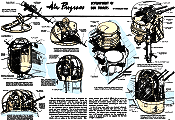 Pilots of the very first airplanes used
for military purposes simply fired pistols and rifles from their open cockpits toward
ground targets, and even other airborne targets (airplanes and balloons). Soon thereafter,
machine guns were mounted to the upper wing and/or wing struts of biplanes. Once
synchronization mechanisms were developed to permit firing through the propeller,
guns were mounted directly in front of the cockpit, on the fuselage, giving the
pilot the advantage of directly sighting for firing. When the target is large and/or
the size of the ammunition is large enough to inflict significant damage regardless
of where it hits, then being able to draw a visual bead on the sweet spot is not
as important. Next came separate gunners who were stationed above, below, in front
of, and behind the pilot, depending on the design and size of the ship. The gunner
had freedom of movement to move the gun around relative to the way the airplane
was pointing, and he was not encumbered with having to fly the plane at the same
time ... Master artist Douglas Rolfe provided this group of drawings representing
the evolution of
aircraft gun turrets. It appeared in a 1948 issue of Air Trails
magazine... Pilots of the very first airplanes used
for military purposes simply fired pistols and rifles from their open cockpits toward
ground targets, and even other airborne targets (airplanes and balloons). Soon thereafter,
machine guns were mounted to the upper wing and/or wing struts of biplanes. Once
synchronization mechanisms were developed to permit firing through the propeller,
guns were mounted directly in front of the cockpit, on the fuselage, giving the
pilot the advantage of directly sighting for firing. When the target is large and/or
the size of the ammunition is large enough to inflict significant damage regardless
of where it hits, then being able to draw a visual bead on the sweet spot is not
as important. Next came separate gunners who were stationed above, below, in front
of, and behind the pilot, depending on the design and size of the ship. The gunner
had freedom of movement to move the gun around relative to the way the airplane
was pointing, and he was not encumbered with having to fly the plane at the same
time ... Master artist Douglas Rolfe provided this group of drawings representing
the evolution of
aircraft gun turrets. It appeared in a 1948 issue of Air Trails
magazine...
 Website visitor Mark Radcliff (yes, THE
Mark Radcliff, of 75-77-79-81 USA F3a RC Aerobatic Team fame, and until recently,
VP of that AMA's District III) wrote to request that I scan the article for
Steve Wooley's control
line Argus, which, appeared in the August 1961 American Modeler magazine. The
Argus was the star of the 1960 world championships in Hungary. Note the unique wing
construction where rather than using full ribs, upper and lower outlines are used
that sit over and under the beefy solid wing spar. The entire article is very short... Website visitor Mark Radcliff (yes, THE
Mark Radcliff, of 75-77-79-81 USA F3a RC Aerobatic Team fame, and until recently,
VP of that AMA's District III) wrote to request that I scan the article for
Steve Wooley's control
line Argus, which, appeared in the August 1961 American Modeler magazine. The
Argus was the star of the 1960 world championships in Hungary. Note the unique wing
construction where rather than using full ribs, upper and lower outlines are used
that sit over and under the beefy solid wing spar. The entire article is very short...
 Even when you are supremely talented as
both an artist, researcher, and writer, as was Douglas Rolfe, producing the infographics,
paintings, and articles like this 1950 Air Trails magazine piece for the "Air Progress: The Hawker Story" feature, requires an enormous
amount of time and effort. Unlike today where most of the information (accurate
or not) you want is available on the Internet, back in Rolfe's day, a library of
books and magazines was needed to assimilate so much information on a single subject
- in this case the lineage and evolution of the Hawker line of aircraft from its
beginnings in 1912 under the name of Sopwith. In 1950, Hawker's newest airplane
was the P-1050 jet (c1949), which followed Tempest (c1947) Typhoon (c1940), which
became famous during World War II. Hawker merged with Siddeley (Hawker Siddeley
Aircraft) in 1963. Their latest model is the Hawk (now BAE Systems), introduced
in 1976... Even when you are supremely talented as
both an artist, researcher, and writer, as was Douglas Rolfe, producing the infographics,
paintings, and articles like this 1950 Air Trails magazine piece for the "Air Progress: The Hawker Story" feature, requires an enormous
amount of time and effort. Unlike today where most of the information (accurate
or not) you want is available on the Internet, back in Rolfe's day, a library of
books and magazines was needed to assimilate so much information on a single subject
- in this case the lineage and evolution of the Hawker line of aircraft from its
beginnings in 1912 under the name of Sopwith. In 1950, Hawker's newest airplane
was the P-1050 jet (c1949), which followed Tempest (c1947) Typhoon (c1940), which
became famous during World War II. Hawker merged with Siddeley (Hawker Siddeley
Aircraft) in 1963. Their latest model is the Hawk (now BAE Systems), introduced
in 1976...
 The 1956 Annual edition of Air Trails
magazine reports here on the 1955 Air Force Model Airplane Championships held at
Travis Air Force Base, in California. Check out that B-29 control line model entry,
and then see this B-29 model inherited by Boyd Steffe. Back in the good 'ole days,
the U.S. armed forces spent taxpayer money supporting sporting events and hobby
pursuits. It helped increase morale, esprit de corps, technical prowess, physical
fitness, and very importantly, it promoted the service as a career and lifestyle.
Both the Air Force and the Navy were heavily into model aviation by sponsoring competitions
on bases worldwide. The Navy was a prime sponsor of the Academy of Model Aeronautics'
Nationals competition for many years, using its exposure to young men as a recruitment
effort. Today, sadly, such activity is looked upon by our Woke armed forces as White
Privilege and money is instead applied toward gender change operations and lifelong
medical and psychological support... The 1956 Annual edition of Air Trails
magazine reports here on the 1955 Air Force Model Airplane Championships held at
Travis Air Force Base, in California. Check out that B-29 control line model entry,
and then see this B-29 model inherited by Boyd Steffe. Back in the good 'ole days,
the U.S. armed forces spent taxpayer money supporting sporting events and hobby
pursuits. It helped increase morale, esprit de corps, technical prowess, physical
fitness, and very importantly, it promoted the service as a career and lifestyle.
Both the Air Force and the Navy were heavily into model aviation by sponsoring competitions
on bases worldwide. The Navy was a prime sponsor of the Academy of Model Aeronautics'
Nationals competition for many years, using its exposure to young men as a recruitment
effort. Today, sadly, such activity is looked upon by our Woke armed forces as White
Privilege and money is instead applied toward gender change operations and lifelong
medical and psychological support...
 Fox model airplane engines had a reputation
for ruggedness and contest-winning performance, but were also notoriously difficult
to get started - at least without an electric starter. In 1961, when this full-page
advertisement appeared in American Modeler magazine, electric starters were not
in many modelers' field boxes, and particularly those owned by youngsters whose
modeling budget came from meager allowances and paper routes. Born in 1958, I was
15 or 16 years old before being able to afford the luxury, and I remember relentlessly
flipping the propellers on my Fox 15 and Fox 35 control line engines. Half the time
when they started, they were running backwards and had to be stopped with a rag
thrown into the prop, then the process started over again. Ugh. ...but I digress.
Fox prided itself on their use of Meehanite iron for the piston. Per Wikipedia:
"Meehanite is a trademark for an engineering process to make a range of cast irons
produced under specific and carefully controlled conditions to precise internationally
recognized specifications." I don't know what the difference is between the standard
Fox engines and the "X" series. My Fox 15 and Fox 35, which I still have, are the
standard non-X variety... Fox model airplane engines had a reputation
for ruggedness and contest-winning performance, but were also notoriously difficult
to get started - at least without an electric starter. In 1961, when this full-page
advertisement appeared in American Modeler magazine, electric starters were not
in many modelers' field boxes, and particularly those owned by youngsters whose
modeling budget came from meager allowances and paper routes. Born in 1958, I was
15 or 16 years old before being able to afford the luxury, and I remember relentlessly
flipping the propellers on my Fox 15 and Fox 35 control line engines. Half the time
when they started, they were running backwards and had to be stopped with a rag
thrown into the prop, then the process started over again. Ugh. ...but I digress.
Fox prided itself on their use of Meehanite iron for the piston. Per Wikipedia:
"Meehanite is a trademark for an engineering process to make a range of cast irons
produced under specific and carefully controlled conditions to precise internationally
recognized specifications." I don't know what the difference is between the standard
Fox engines and the "X" series. My Fox 15 and Fox 35, which I still have, are the
standard non-X variety...
 Indoor airplane models covered with
microfilm seem to have always been for a very particular, dedicated
group of modelers who possess the patience, steady hands, and eyesight (aided or
not) to build and maintain very delicate structures. A directed sneeze can literally
blow them to pieces. It is an aspect of aeromodeling into which I have never ventured.
Mr. Joseph Bilgri, AMA #4393, was a contest-winning pioneer of the craft. The AMA
History Project has a biography of Joe that is worth reading if you have an interest
in indoor modeling. Of course today, with the advent of nano-size radio controlled
and free flight models, the realm of indoor flying has increased considerably beyond
wire-framed surfaces covered with bubble-thin sheets of microfilm. This 3-part series
on indoor models begins with a construction article and ends with proven methods
for successfully repairing damage. It appeared in the March 1971 issue of American
Aircraft Modeler magazine... Indoor airplane models covered with
microfilm seem to have always been for a very particular, dedicated
group of modelers who possess the patience, steady hands, and eyesight (aided or
not) to build and maintain very delicate structures. A directed sneeze can literally
blow them to pieces. It is an aspect of aeromodeling into which I have never ventured.
Mr. Joseph Bilgri, AMA #4393, was a contest-winning pioneer of the craft. The AMA
History Project has a biography of Joe that is worth reading if you have an interest
in indoor modeling. Of course today, with the advent of nano-size radio controlled
and free flight models, the realm of indoor flying has increased considerably beyond
wire-framed surfaces covered with bubble-thin sheets of microfilm. This 3-part series
on indoor models begins with a construction article and ends with proven methods
for successfully repairing damage. It appeared in the March 1971 issue of American
Aircraft Modeler magazine...
 Boeing's Stratoliner was America's answer
to Britain's The de Havilland DH.106 Comet commercial airliner. The Comet's maiden
flight occurred on July 27, 1949, and it entered into commercial service with British
Overseas Airways Corporation (BOAC) on May 2, 1952. This 1954 Popular Science
magazine article reported on the first test flight of the Stratoliner. The article
is not clear what its production designation would be, but the best information
I can find, based on maiden flight dates, indicates it was the Boeing 367-80, which
became the basis for the Boeing 707. The Wikipedia entry shows the factory-roll-out
photo included in this article. There was also a Boeing C-137 Stratoliner military
version. While Boeing's top test pilot Alvin "Text" Johnston is mentioned in the
article, what is not mentioned is the unauthorized barrel roll he performed in the
Stratoliner during a demonstration flight over Lake Washington, near Seattle, with
the company president watching from his yacht! Boeing's Stratoliner was America's answer
to Britain's The de Havilland DH.106 Comet commercial airliner. The Comet's maiden
flight occurred on July 27, 1949, and it entered into commercial service with British
Overseas Airways Corporation (BOAC) on May 2, 1952. This 1954 Popular Science
magazine article reported on the first test flight of the Stratoliner. The article
is not clear what its production designation would be, but the best information
I can find, based on maiden flight dates, indicates it was the Boeing 367-80, which
became the basis for the Boeing 707. The Wikipedia entry shows the factory-roll-out
photo included in this article. There was also a Boeing C-137 Stratoliner military
version. While Boeing's top test pilot Alvin "Text" Johnston is mentioned in the
article, what is not mentioned is the unauthorized barrel roll he performed in the
Stratoliner during a demonstration flight over Lake Washington, near Seattle, with
the company president watching from his yacht!
 The [George Ellery]
Hale 200−inch telescope saw first light (first official observation)
atop Palomar Mountain, in southern California, on January 26, 1949. That was a decade
after this early report on its planning appeared in a 1938 issue of Boy's Life
magazine (the official publication of the Boy Scouts of America, BSA). It held the
title of the world's largest telescope until Russia commissioned its 605 cm
(238 in.) BTA-6 in 1976. As of this writing, the telescope with the largest
light collecting capacity is the Large Binocular Telescope (LBT) on Mount Graham,
in the Pinaleno Mountains of southeastern Arizona. When using both 330 inch mirrors,
the LBT has the same light-gathering ability as a 464 inch single telescope and
the resolution of a 897 inch wide one... The [George Ellery]
Hale 200−inch telescope saw first light (first official observation)
atop Palomar Mountain, in southern California, on January 26, 1949. That was a decade
after this early report on its planning appeared in a 1938 issue of Boy's Life
magazine (the official publication of the Boy Scouts of America, BSA). It held the
title of the world's largest telescope until Russia commissioned its 605 cm
(238 in.) BTA-6 in 1976. As of this writing, the telescope with the largest
light collecting capacity is the Large Binocular Telescope (LBT) on Mount Graham,
in the Pinaleno Mountains of southeastern Arizona. When using both 330 inch mirrors,
the LBT has the same light-gathering ability as a 464 inch single telescope and
the resolution of a 897 inch wide one...
 On April 8, 2024, one of the best total
solar eclipses of the last century crossed the United States from
Texas to Maine. Because the moon was near its closest orbital point to the Earth,
and the Earth was about midway between its orbital apogee and perigee, the sun appeared
relatively small and the moon appeared relatively large. That combination caused
the moon's shadow to be very wide across the face of the Earth. Note in the NASA
eclipse map at the right how much narrower the path of totality was for the August
17, 2017 eclipse. Maximum eclipse for this location was just shy of 81%. That was
enough to cause an eerie feel in the sky, but it was nowhere near dark. Let me state
that when I first became aware of this solar eclipse, it was sometime around 2016,
when I was living in Erie, Pennsylvania. Due to scheduling issues, Melanie and I
decided to not travel to South Carolina to view the August 21, 2017 eclipse,
figuring we would have a front-row seat to it on April 8, 2024, from our house,
which was only a few miles from the center of the path of totality. Life happened,
and we ended up moving back to North Carolina in 2022. Because hotel rooms just
about anywhere in the path of totality were in the $300+ per night range, we stayed
here and missed totality... On April 8, 2024, one of the best total
solar eclipses of the last century crossed the United States from
Texas to Maine. Because the moon was near its closest orbital point to the Earth,
and the Earth was about midway between its orbital apogee and perigee, the sun appeared
relatively small and the moon appeared relatively large. That combination caused
the moon's shadow to be very wide across the face of the Earth. Note in the NASA
eclipse map at the right how much narrower the path of totality was for the August
17, 2017 eclipse. Maximum eclipse for this location was just shy of 81%. That was
enough to cause an eerie feel in the sky, but it was nowhere near dark. Let me state
that when I first became aware of this solar eclipse, it was sometime around 2016,
when I was living in Erie, Pennsylvania. Due to scheduling issues, Melanie and I
decided to not travel to South Carolina to view the August 21, 2017 eclipse,
figuring we would have a front-row seat to it on April 8, 2024, from our house,
which was only a few miles from the center of the path of totality. Life happened,
and we ended up moving back to North Carolina in 2022. Because hotel rooms just
about anywhere in the path of totality were in the $300+ per night range, we stayed
here and missed totality...
 "When
a rare
total solar eclipse sweeps across North America on April 8, scientists
will be able to gather invaluable data on everything from the Sun's atmosphere to
strange animal behaviors - and even possible effects on humans. It comes with the
Sun near the peak of its 11-year solar cycle, setting the stage for a breathtaking
display: The corona will glow spectacularly from the Moon's silhouette along the
path of totality, a corridor stretching from Mexico to Canada via the United States.
Total solar eclipses offer 'incredible scientific opportunities,' NASA Deputy Administrator
Pam Melroy told a press conference this week about the celestial event. The U.S.
space agency is one of the institutions at the ready for the eclipse, with plans
to launch so-called 'sounding rockets' to study the effects on Earth's upper atmosphere.
Here is a look at what researchers are hoping to learn from the upcoming eclipse.
'Things are happening with the corona that we don't fully understand,' she said.
The heat within the corona intensifies with distance from the Sun's surface - a
counterintuitive phenomenon that scientists struggle to fully comprehend or explain..." "When
a rare
total solar eclipse sweeps across North America on April 8, scientists
will be able to gather invaluable data on everything from the Sun's atmosphere to
strange animal behaviors - and even possible effects on humans. It comes with the
Sun near the peak of its 11-year solar cycle, setting the stage for a breathtaking
display: The corona will glow spectacularly from the Moon's silhouette along the
path of totality, a corridor stretching from Mexico to Canada via the United States.
Total solar eclipses offer 'incredible scientific opportunities,' NASA Deputy Administrator
Pam Melroy told a press conference this week about the celestial event. The U.S.
space agency is one of the institutions at the ready for the eclipse, with plans
to launch so-called 'sounding rockets' to study the effects on Earth's upper atmosphere.
Here is a look at what researchers are hoping to learn from the upcoming eclipse.
'Things are happening with the corona that we don't fully understand,' she said.
The heat within the corona intensifies with distance from the Sun's surface - a
counterintuitive phenomenon that scientists struggle to fully comprehend or explain..."
|



